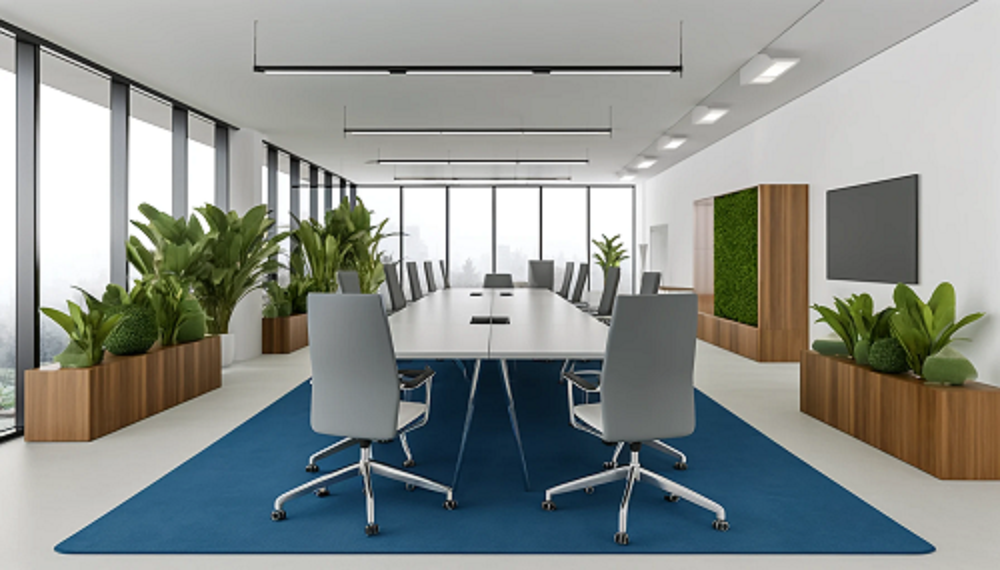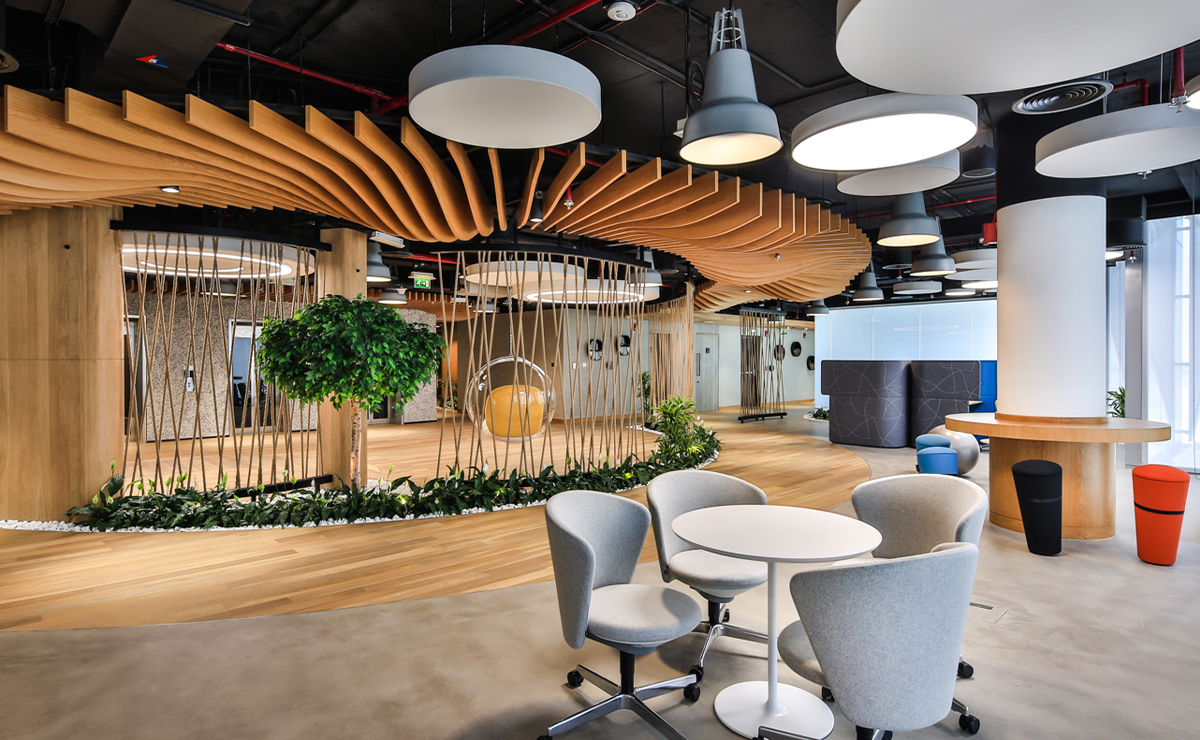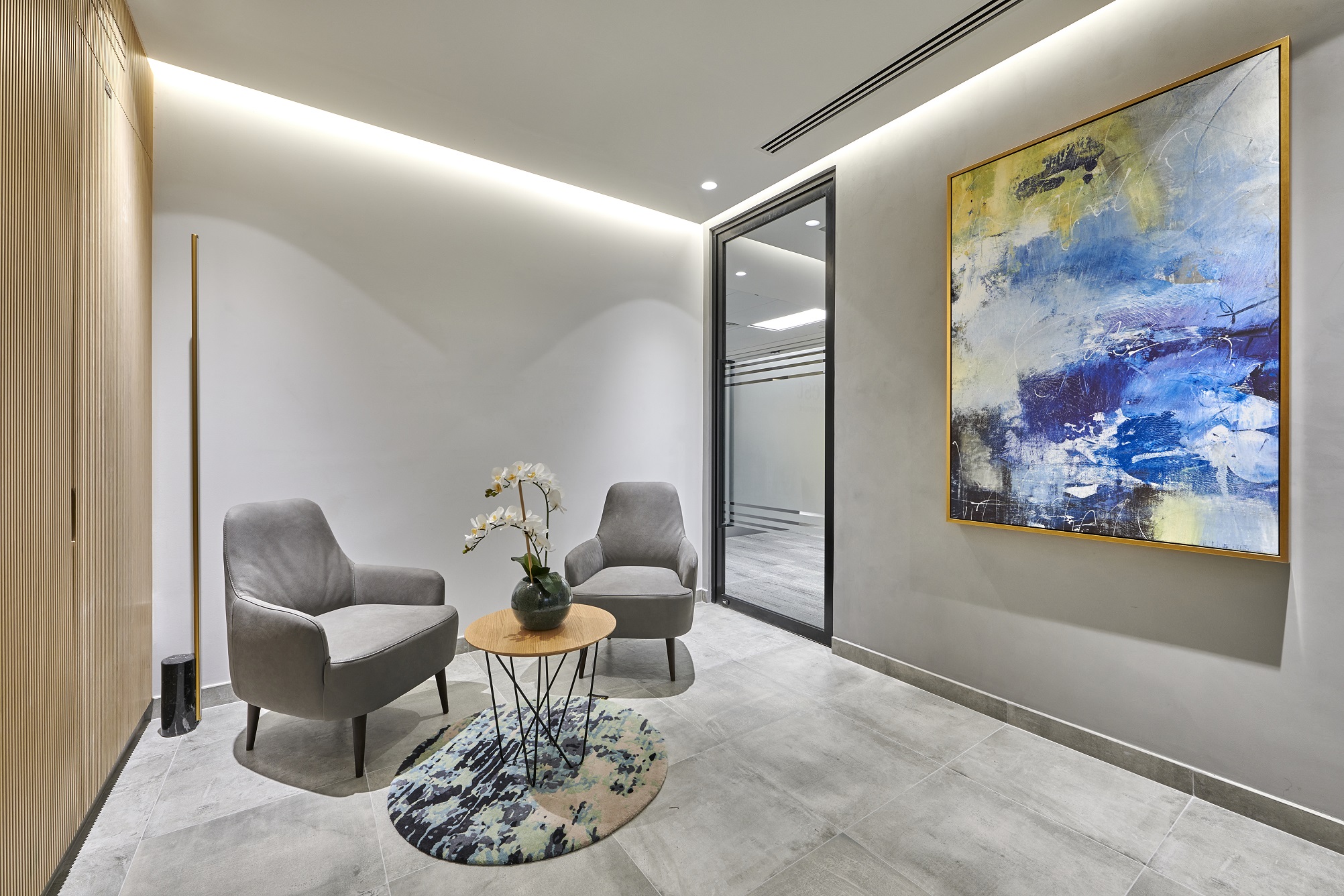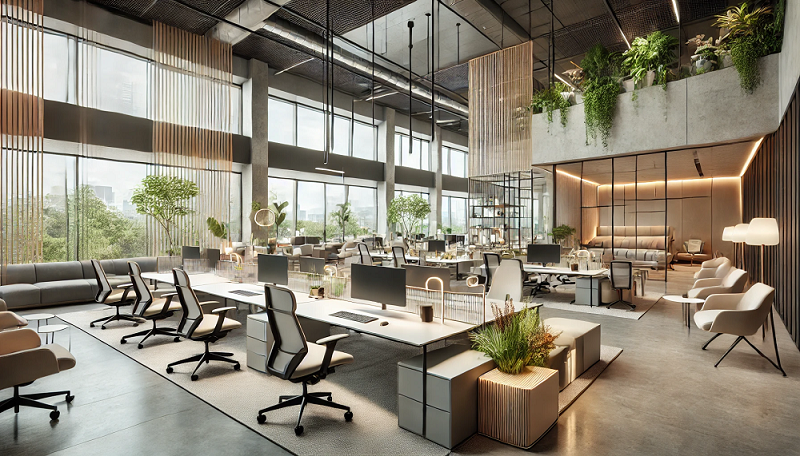

Nicola Trivett
General Manager & Sustainability Leader
The rise of eco-friendly materials in office interior design marks a significant shift towards sustainability. As businesses become more aware of their environmental footprint, the demand for sustainable alternatives to traditional building materials has grown substantially. This movement towards greener office spaces is not only driven by environmental concerns but also by the benefits that sustainable materials offer in terms of health, aesthetics, and long-term financial savings.
Traditional office materials, such as conventional paints, plastics, and untreated woods, often contribute to various environmental issues. These materials can release harmful volatile organic compounds (VOCs) into the air, contribute to deforestation, and create significant amounts of waste. The production and disposal of these materials are energy-intensive processes that lead to higher carbon emissions, exacerbating climate change. As a result, the need for sustainable alternatives has become more pressing than ever.
Eco-friendly materials offer a viable solution to these problems. By reducing waste, lowering emissions, and improving indoor air quality, these materials help create healthier and more sustainable work environments. The following sections will explore various types of eco-friendly materials, their innovative applications, sourcing and supply chain considerations, cost and durability, and the future trends in sustainable office interiors.
Types of Eco-friendly Materials
Eco-friendly materials encompass a wide range of products that are designed to reduce environmental impact while providing practical benefits in office design. Some of the most notable materials include reclaimed wood, recycled metal, and low-VOC paints.
Reclaimed Wood
Sourced from old buildings, barns, and warehouses, giving it a unique character and history. Its use in office interiors not only prevents waste from ending up in landfills but also reduces the need for new timber, thereby conserving forests. Reclaimed wood is commonly used for desks, shelving, and flooring, providing a rustic and warm aesthetic that enhances the office environment.
Recycled Metal
Recycled metal, another popular eco-friendly material, is obtained from scrapped vehicles, old machinery, and industrial waste. This material is highly durable and strong, making it suitable for furniture frames, partitions, and other structural elements in an office. Using recycled metal reduces the need for new metal production, which is a highly energy-intensive process, thus lowering the overall carbon footprint of the office fit out.
Non-Toxic Paints
Low-VOC paints are designed to reduce the emission of volatile organic compounds, which are harmful to both human health and the environment. Traditional paints release VOCs into the air, contributing to indoor air pollution and various health issues such as headaches and respiratory problems. Low-VOC paints, on the other hand, offer a safer alternative, making them ideal for use on walls, furniture, and other surfaces in office interiors.
These eco-friendly materials not only help in reducing environmental impact but also offer various practical benefits. Their durability, aesthetic appeal, and health advantages make them an excellent choice for modern office interiors seeking to promote sustainability.
Innovative Applications
Innovative applications of eco-friendly materials in office design showcase the creativity and ingenuity of architects and interior designers. These applications not only highlight the versatility of sustainable materials but also demonstrate how they can enhance both the functionality and aesthetics of office spaces.
Green Walls and Roofs
One notable example is the use of green walls and roofs. Companies like Google and Amazon have incorporated vertical gardens and green roofs into their office designs. These green spaces improve indoor air quality by absorbing pollutants and releasing oxygen. Additionally, they provide natural insulation, reducing the need for artificial heating and cooling, thereby lowering energy consumption. The visual appeal of green walls and roofs also creates a more pleasant and inspiring work environment.
Furnishing with Recycled Materials
Recycled plastic furniture is another innovative application that has gained popularity in recent years. Companies such as Herman Miller and Steelcase have developed office furniture made from recycled plastic. This approach not only reduces plastic waste but also creates durable and aesthetically pleasing furniture. Recycled plastic chairs, desks, and storage units are not only environmentally friendly but also offer ergonomic designs that enhance employee comfort and productivity.
Staying Sustainable with Bamboo
Furthermore, the integration of eco-friendly materials in office interiors can be seen in the use of bamboo. Bamboo is a fast-growing, renewable resource that is incredibly versatile. It can be used for flooring, furniture, and even wall coverings. Its natural look and durability make it an ideal material for creating sustainable and stylish office interiors.
These innovative applications of eco-friendly materials demonstrate how sustainability can be seamlessly integrated into office design. By adopting such practices, businesses can create healthier, more productive, and environmentally responsible workspaces.
Sourcing and Supply Chain
Sustainable sourcing practices are crucial for ensuring that eco-friendly materials truly benefit the environment. Responsible sourcing involves obtaining materials in a way that preserves natural resources, supports local communities, and reduces environmental degradation.
Challenges in Sourcing
One of the primary challenges in sourcing eco-friendly materials is their availability. While the demand for sustainable products is increasing, the supply chain for these materials is still developing. This can lead to higher costs and longer lead times. However, businesses can overcome these challenges by partnering with certified suppliers who adhere to sustainable practices. Certification programs, such as those provided by the Forest Stewardship Council (FSC) and the Global Organic Textile Standard (GOTS), ensure that materials are sourced responsibly and meet stringent environmental standards.
Role of Suppliers and Manufacturers
Suppliers and manufacturers play a critical role in promoting sustainability. By offering transparency in their sourcing processes and obtaining certifications, they can help businesses make informed decisions about the materials they use. Additionally, suppliers can innovate by developing new sustainable materials and improving the efficiency of their production processes, further reducing the environmental impact.
Local Sourcing Benefits
The supply chain for eco-friendly materials often involves local sourcing, which reduces the carbon footprint associated with transportation. Supporting local suppliers not only benefits the environment but also strengthens local economies and promotes community development.
Overall, sustainable sourcing and a transparent supply chain are essential components of eco-friendly office design. By addressing the challenges and leveraging the opportunities within the supply chain, businesses can contribute to a more sustainable future.
Cost and Durability
When considering the adoption of eco-friendly materials, cost and durability are significant factors for businesses. While the initial investment in sustainable materials can be higher than traditional options, the long-term benefits often outweigh these costs.
Cost Comparison
Eco-friendly materials tend to have longer lifespans and require less maintenance compared to their traditional counterparts. For example, reclaimed wood and recycled metal are known for their durability and resistance to wear and tear. This means that over time, businesses can save on replacement and maintenance costs. Additionally, materials like low-VOC paints contribute to better indoor air quality, reducing health-related costs and improving employee well-being and productivity.
Financial Incentives
The initial cost of eco-friendly materials can be offset by various financial incentives and grants available to businesses that commit to sustainable practices. Many governments and organisations offer subsidies, tax credits, and grants to encourage the use of environmentally friendly materials. These financial incentives can significantly reduce the overall cost of adopting sustainable materials in office interiors.
Long-term Savings
The long-term savings associated with reduced energy consumption and maintenance costs make eco-friendly materials a cost-effective choice. For instance, green roofs and walls provide natural insulation, which can lower heating and cooling costs. Similarly, energy-efficient lighting and HVAC systems can further enhance the financial benefits of sustainable office design.
Therefore, while the upfront cost of eco-friendly materials may be higher, the long-term savings and benefits make them a financially viable option for businesses looking to create sustainable and healthy office environments.
Sustainable Office Interiors: The Way Forward
Eco-friendly materials provide sustainable, durable, and aesthetically pleasing alternatives to traditional materials. As businesses increasingly recognise the environmental and health benefits of these materials, the adoption of sustainable practices in office design is set to grow. Innovations like green walls, recycled plastic furniture, and bamboo flooring are some of the sustainable options transforming workspaces – making them not only more eco-friendly but also more vibrant and inspiring.

At Summertown, our commitment to sustainable practices is evident in our numerous certified projects. By incorporating eco-friendly materials into our fit outs, we create office spaces that are functional, stylish, and environmentally responsible. Our comprehensive approach tackles sourcing challenges through partnerships with certified suppliers, and our expertise in innovative applications and LEED certification helps businesses achieve their sustainability goals.
Take the first step towards a sustainable and stylish office transformation – contact us today to learn more about how we can help you create an eco-friendly workspace that benefits both your employees and the environment.
Embracing Eco-friendly Office Design: A Sustainable Future
Eco-friendly materials provide sustainable, durable, and aesthetically pleasing alternatives to traditional materials. As businesses increasingly recognise the environmental and health benefits of these materials, the adoption of sustainable practices in office design is only set to grow. Innovations like green walls, recycled plastic furniture, and bamboo flooring are transforming workspaces, making them not only more eco-friendly but also more vibrant and inspiring.
Looking ahead, advancements in bio-based materials, such as mycelium and algae, will offer new possibilities for eco-friendly office design. Innovations in recycling technologies and the development of more efficient supply chains will also play crucial roles in making sustainable materials more accessible and affordable. The shift towards sustainable office interiors is not just about environmental responsibility; it also makes sound economic sense. Long-term cost savings, coupled with financial incentives and the potential for enhanced employee well-being, make sustainable office design an attractive proposition.
At Summertown, we have a proven track record of delivering LEED-certified projects that combine sustainability with elegance. Our commitment to using eco-friendly materials and innovative design solutions ensures your office space is both functional and inspiring. Contact us today to explore how we can help you create a workspace that aligns with your sustainability goals and reflects a modern, responsible approach to office design.
Sources:
- Bauer, K. (2020). “Sustainable Materials for Interior Design.” Journal of Interior Design, 45(4), 59-74.
- Construction Today (2022). “The Durability of Eco-friendly Building Materials.” Retrieved from Construction Today.
- Environmental Finance (2021). “Financial Incentives for Green Building.” Retrieved from Environmental Finance.
- FSC Global Development (2021). “The Role of Certification in Promoting Sustainable Sourcing.” Retrieved from FSC.
- Herman Miller (2023). “Recycled Plastic Furniture: Innovations and Applications.” Retrieved from Herman Miller.
- Kibert, C. J. (2016). “Sustainable Construction: Green Building Design and Delivery.” John Wiley & Sons.
- Smith, P. (2020). “Comparing Costs of Sustainable vs. Traditional Materials.” Construction Economics Journal, 34(3), 67-82.
- Sustainable Bamboo Project (2022). “Bamboo: A Sustainable Solution for Modern Interiors.” Retrieved from Sustainable Bamboo Project.
- The Green Building Council (2022). “Sustainable Sourcing in Construction.” Retrieved from GBC
- The World Green Building Council (2021). “Green Walls and Roofs in Office Spaces.” Retrieved from World GBC.
- Thompson, A. (2022). “The Benefits of Recycled Metal in Office Design.” Architectural Digest. Retrieved from Architectural Digest.
- US Green Building Council (2022). “LEED Certification and its Benefits.” Retrieved from USGBC.
- U.S. Environmental Protection Agency (EPA). “Low-VOC Paints and Coatings.” Retrieved from EPA.
- Wilson, A. (2021). “Reclaimed Wood: Sustainable, Beautiful, Unique.” Green Building Advisor. Retrieved from Green Building Advisor.
- World Green Building Council (2023). “Future Trends in Sustainable Office Materials.” Retrieved from World GBC.

Nicola Trivett
General Manager & Sustainability Leader




















